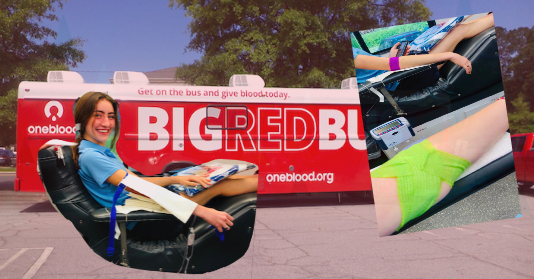Interact Hosts Annual Blood Drive
November 22, 2019
On Thursday, November 22, One Blood visited Academy to allow students to participate in a blood drive. From 9 am until 3:45 pm, the bloodmobile hosted AHN students and faculty to raise awareness and provide an accessible place to donate blood.
The drive is endorsed through the Medical Explorers club, who made the informational posters seen in AHN’s hallways.
“Donating takes about 15 minutes and can save three lives. You get free food, free breakfast, lunch, and snacks,” says Medical Expolers President Lauren Jones (‘20).
There is always a need for blood and all donations are voluntary, meaning that hospitals rely on volunteers to supply their blood bank. About 5 million blood transfusions are needed every year, however, less than 10% of the eligible U.S. population donates annually.
Blood is involved in a plethora of medical treatments, including cancer, heart surgery, sickle cell disease, transplants, anemia, and premature infant care. There is no substitute for human blood, nor can it be manufactured, making it all the more important for hospitals to have. There are also different types of blood in which a patient can accept.
“I wanted to donate because even though I’m super scared of needles, I thought how many other chances I would get to save lives while sitting down for 30 minutes and getting free food. It was pretty disappointing when I found out I couldn’t donate,” says Maya Harrell (’20).
There are four main blood cell types, discovered by Dr. Karl Landsteiner in 1901: A, B, AB, and O. Each can be positive or negative. Type AB blood is the universal acceptor (meaning a patient with AB blood can receive any of the other blood types) and O negative is the universal donor (any blood type can receive O negative blood). One unit of blood contains red blood cells, plasma, and platelets, all of which can be separated and donated.
https://www.instagram.com/p/ByuF_xMh_qj/?utm_source=ig_web_button_share_sheet
“There is always a shortage of blood, so there is always a need for it. It gets used immediately – the people on the buses tell us that it will get used on the weekend. You can be confident that your blood is going to three different people, so it’s very worthwhile,” says Paige Rodriguez, blood drive organizer.
Blood donations are vital for many patients, but donating blood also benefits the donor. Donating blood:
- Prevents Hemochromatosis – Hemochromatosis arises from excessive iron absorption in the body, using inherited or due to other disorders including alcoholism and anemia. Donating blood helps keep these iron levels in check and may help in reducing iron overload.
- Anti-Cancer Benefits – Donating blood maintains iron stores at healthy levels. A reduction in the iron level in the body is linked with low cancer risk.
- Maintains Healthy Heart and Liver – Excess iron gets stored in the heart, liver, and pancreas, therefore increasing the risk of cirrhosis, liver failure, damage to the pancreas, and heart abnormalities like irregular heart rhythms. Blood donation helps in maintaining iron levels.
- Weight Loss – Regular blood donation reduces the weight of the donors.
- Stimulates Blood Cell Production – After donating, the body works to replenish the blood loss, stimulating blood cell production and helps maintain good health.
Today has been such a great day and to top it off I donated blood ? #Greatday #BloodDonor pic.twitter.com/X9BBn1aH0h
— sarah Louise (@sarahlouise1804) November 7, 2019
Blood donations can be made every 56 days and your body would have made up for the blood donated in three days’ time. Blood drives hosted by companies, schools, places of worship and civic organizations supply roughly half of all blood donations across the U.S., making it all the more important that AHN hosts such an event.
“I donated because I really wanted to help save lives. It was a relaxing experience and everyone was so nice,” says Claire Murphy (‘20)

